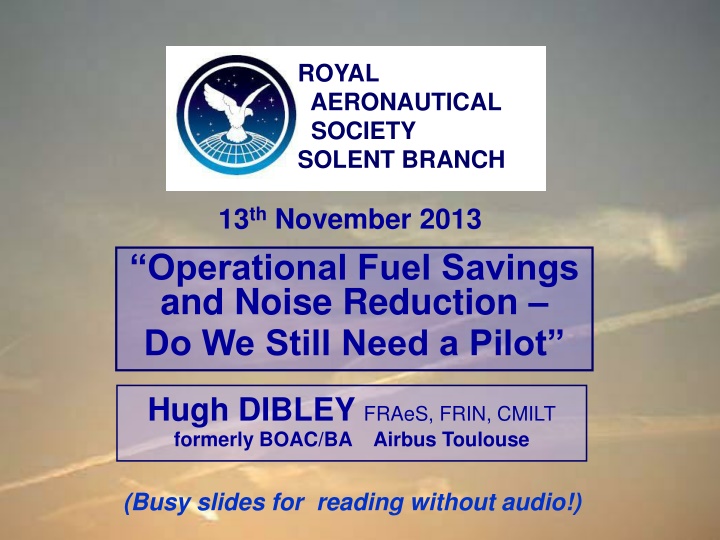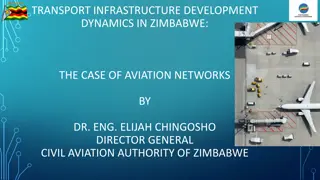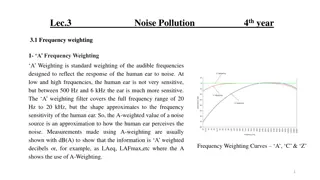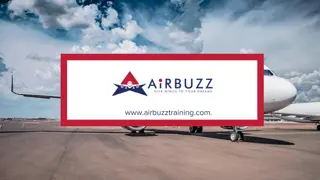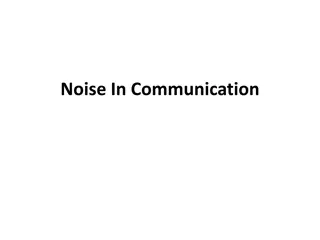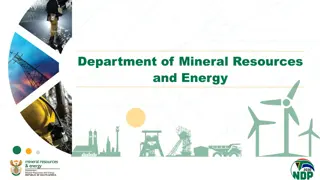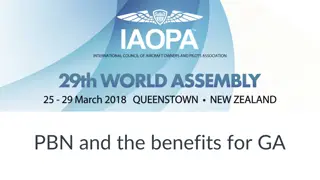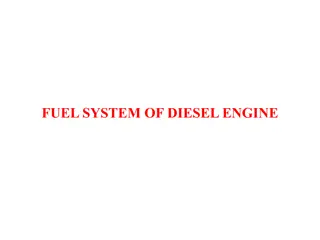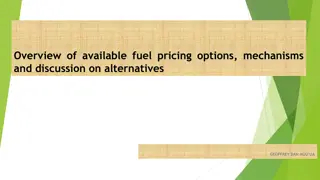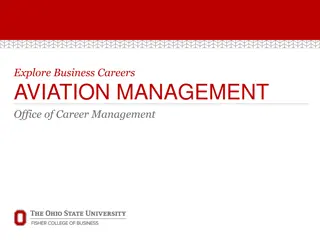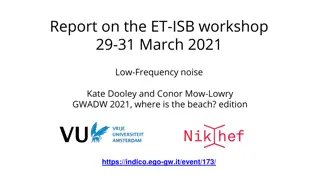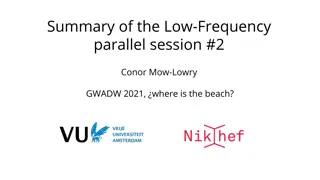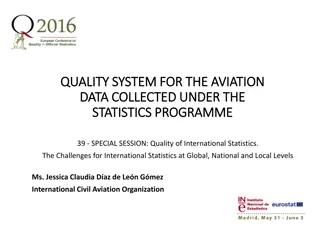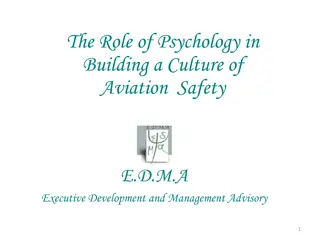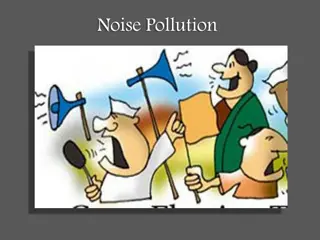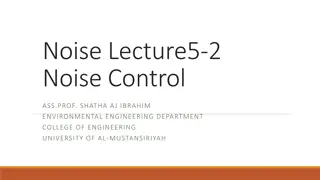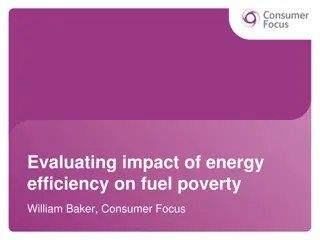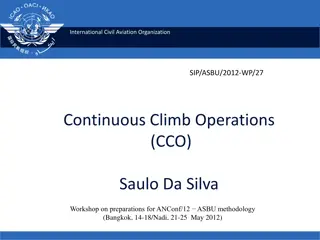Operational Fuel Savings and Noise Reduction in Aviation: A Pilot's Perspective
Delve into the fascinating world of aviation with a focus on operational fuel savings and noise reduction, as presented by Hugh Dibley at the Royal Aeronautical Society Solent Branch in 2013. Explore the evolving role of pilots in aircraft operations and the potential impact on safety. Gain insights into the past, present, and future perspectives on this crucial aspect of aviation technology and innovation.
Download Presentation

Please find below an Image/Link to download the presentation.
The content on the website is provided AS IS for your information and personal use only. It may not be sold, licensed, or shared on other websites without obtaining consent from the author.If you encounter any issues during the download, it is possible that the publisher has removed the file from their server.
You are allowed to download the files provided on this website for personal or commercial use, subject to the condition that they are used lawfully. All files are the property of their respective owners.
The content on the website is provided AS IS for your information and personal use only. It may not be sold, licensed, or shared on other websites without obtaining consent from the author.
E N D
Presentation Transcript
ROYAL AERONAUTICAL SOCIETY SOLENT BRANCH 13th November 2013 Operational Fuel Savings and Noise Reduction Do We Still Need a Pilot Hugh DIBLEY FRAeS, FRIN, CMILT formerly BOAC/BA Airbus Toulouse (Busy slides for reading without audio!)
1st Airbus A380 Transport of Components & Final Assembly RAeS Solent Branch 13 Nov 2013 Hugh DIBLEY Operational Fuel Savings & Noise Reduction, Do We Still Need a Pilot? 2 /124
ROYAL AERONAUTICAL SOCIETY SOLENT BRANCH 13th November 2013 Operational Fuel Savings and Noise Reduction Do We Still Need a Pilot Hugh DIBLEY FRAeS, FRIN, CMILT formerly BOAC/BA Airbus Toulouse (Busy slides for reading without audio!)
RAeS Solent Branch 13 Nov 2013 Hugh DIBLEY Operational Fuel Savings & Noise Reduction, Do We Still Need a Pilot? 6 /124
RAeS Solent Branch 13 Nov 2013 Hugh DIBLEY Operational Fuel Savings & Noise Reduction, Do We Still Need a Pilot? 7 /124
Graduates/ Associates of Who have given lecture to the RAeS Toulouse Branch David Baxter Kenji Takeda Peter Chandler Airbus Chief Test Pilot Commanded 1st Flight of Airbus A350 14 June 2013 Dave MacKay Chief Test Pilot Virgin Galactic RAeS Solent Branch 13 Nov 2013 Hugh DIBLEY Operational Fuel Savings & Noise Reduction, Do We Still Need a Pilot? 8 /124
Background to Presentation 2003 Branches Conference RAeS President Prof Ian POLL, 100 Years of Manned Flight Remove pilot to improve safety! . Aircraft Operational Fuel Savings & Noise Reduction - Past & Future Ian Poll s reaction: I never realised pilots did so much I must change my view. 2009 CEAS Manchester H Dibley lecture, chaired by Ian Poll: RAeS 2010 Aerospace Statement: Pilots will go as we have led with driverless trains Extra section added related to safety Do we need a pilot? RAeS Solent Branch 13 Nov 2013 Hugh DIBLEY Operational Fuel Savings & Noise Reduction, Do We Still Need a Pilot? 9 /124
Operational Fuel Savings & Noise Reduction Past & Future 1. 2. 3. 4. 5. 6. 7. 8. 9. 10. Past Examples of Operational Fuel Savings 11. Possible Future Operational Fuel Savings 12. Future ATM Fuel Savings Being Achieved NOW USA 13. Future ATM Fuel Savings Being Achieved NOW - Europe Simplified Aircraft Flight Profile for a Single Aircraft Efficiency Loss as ATC must Separate Aircraft then Merge to Land Pre-Flight Planning Cost of Carrying Extra Fuel on the Sector Departure Noise Abatement Procedures Cruise - Fuel Savings & Crew Situational Awareness Descent Large opportunity for Fuel Savings and safety in approach Approach Large opportunity for Fuel Savings & Noise Reduction Steep Approaches to reduce noise? Crews Ability to Save Fuel/Time by Choosing Approach & Runway RAeS Solent Branch 13 Nov 2013 Hugh DIBLEY Operational Fuel Savings & Noise Reduction, Do We Still Need a Pilot? 10 /124
1. Simplified Aircraft Flight Profile for a Single Aircraft Single aircraft Efficiency is reduced by the need for ATC to separate aircraft to avoid conflicts then merge again for landing RAeS Solent Branch 13 Nov 2013 Hugh DIBLEY Operational Fuel Savings & Noise Reduction, Do We Still Need a Pilot? 11 /124
2. Efficiency Loss as ATC must Separate Aircraft then Merge to Land As aircraft approach their destination, ATC must merge aircraft into a stream to the runway to achieve the most efficient landing rate. At present this is usually achieved by ATC giving aircraft headings and speeds to fly at low levels which stretch the approach path while aircraft are placed in sequence at the required spacing for the type causing extra fuel consumption and noise over the ground. New Air Traffic Management Systems will merge aircraft into their landing sequence earlier in the flight, and allow more efficient descents with idle thrust leading to quieter Constant Descent Approaches with no periods of level flight. The complexity of the process to merge traffic efficiently can be seen from the aircraft tracks into Schiphol airport at Amsterdam and simulations of the Paris arrival routes. Simulation of Paris Arrivals RAeS Solent Branch 13 Nov 2013 Hugh DIBLEY Operational Fuel Savings & Noise Reduction, Do We Still Need a Pilot? 12 /124
Maximize Take-off Weight Prime Requirement Sound Knowledge of Take-off Performance Principles To Take-off at the Maximum Allowable Weight for the Conditions RAeS Solent Branch 13 Nov 2013 Hugh DIBLEY Operational Fuel Savings & Noise Reduction, Do We Still Need a Pilot? 13 /124
3 Pre-Flight Planning Fuel Uplift Must Kept to Minimum Extra weight increases fuel consumption by app 3% per hour Aircraft weight minimised for fuel efficiency composites etc Fuel adds weight so must exactly planned & kept to minimum Extra fuel can be required for expected delays due to: ATC congestion, weather, disasters, industrial action, etc If Fuel Price Much Cheaper at Departure than Destination Carrying in the fuel can be the most efficient means of delivering the fuel. Most often simply commercial differences. RAeS Solent Branch 13 Nov 2013 Hugh DIBLEY Operational Fuel Savings & Noise Reduction, Do We Still Need a Pilot? 14 /124
3 Pre-Flight Planning Cost of carrying extra fuel Carrying extra fuel over the minimum flight plan fuel always involves as penalty due to the extra weight burnt at 3% per hour. The actual cost of extra fuel depends on the relative cost of fuel between the departure and destination airfields. If the fuel is cheap enough at the departure airfield it can be worthwhile carrying/tankering extra fuel into the destination. However the effect of the extra weight on the aircraft must be considered extra landing distance, possible extra brake wear and use of reverse thrust, reduced maximum cruise altitude, etc. This decision is best made by the crew on the day who need to know the cost of extra fuel for the most economic judgement. For example: HKG-NGO Save $127/tonne definitely worth tankering. LHR-BRU Save $1/tonne not worth tanking for fuel price alone. HKG-DEL Cost 1/tonne extra fuel could be cheap insurance if delays en route were likely. NGO-HKG Cost 206 cost of extra fuel prohibitive. Many companies do not publish Fuel Price Differentials but just tell crews when to tanker fuel, which may not be efficient. RAeS Solent Branch 13 Nov 2013 Hugh DIBLEY Operational Fuel Savings & Noise Reduction, Do We Still Need a Pilot? 15 /124
Airbus A380 Payload-Range Diagram Essential Information for Selecting Correct Aircraft RAeS Solent Branch 13 Nov 2013 Hugh DIBLEY Operational Fuel Savings & Noise Reduction, Do We Still Need a Pilot? 16 /124
3 Pre-Flight Planning Cost of Extra Fuel reducing Payload Flight Operations job is to carry Maximum Payload at Minimum Cost Primarily - Uplift minimum fuel and burn the minimum amount in flight On long sectors extra fuel displaces payload thus losing revenue - Loss is extreme on very long sectors when the tanks are already full and the only way to fly further is to reduce the passenger load/weight. RAeS Solent Branch 13 Nov 2013 Hugh DIBLEY Operational Fuel Savings & Noise Reduction, Do We Still Need a Pilot? 17 /124
Flight Operations job is to Carry Maximum Payload at Minimum Cost. Having Uplifted the Minimum amount of Fuel now Operate the aircraft efficiently and Cost effectively to Burn the Minimum Fuel in flight consistent with minimum environmental pollution. RAeS Solent Branch 13 Nov 2013 Hugh DIBLEY Operational Fuel Savings & Noise Reduction, Do We Still Need a Pilot? 18 /124
4. Noise Abatement Departure Procedures 1 & 2 Early turbojet powered aircraft were extremely noisy on takeoff so had to climb steeply to 3,000ft before accelerating to retract flaps and climb at the most efficient speed, shown as NADP 1 in red. Later fan jet engines with colder/slower exhaust streams made less noise so could accelerate sooner and climb more efficiently shown as NADP 2 in green. Noise close to the airport could be increased but was less than from turbojet aircraft, and noise further out is reduced as the aircraft is higher than with NADP 1. RAeS Solent Branch 13 Nov 2013 Hugh DIBLEY Operational Fuel Savings & Noise Reduction, Do We Still Need a Pilot? 19 /124
4. Noise Abatement Departure Procedures 1 & 2 The noise foot print from current large fan jet aircraft is some 75% less than from the early fan jet aircraft, therefore NADP 2 can be used at most airports without causing significant noise disturbance close to the runway. Yet some states specify that the less efficient NADP 1 be followed at airports where urban noise reduction is not a factor. This is causing significant amounts of unnecessary amounts of extra fuel to be burnt and emissions released into the atmosphere at low level. RAeS Solent Branch 13 Nov 2013 Hugh DIBLEY Operational Fuel Savings & Noise Reduction, Do We Still Need a Pilot? 20 /124
4. A380 Aircraft & Engines Optimised for Low Departure Noise Minimising aircraft departure noise is considered to be a critical factor in aircraft design. Rolls-Royce increased the fan size of the Trent 900 for the Airbus A380 to comply with the London Heathrow airport departure noise limits at the highest takeoff weight. Airbus optimised the low speed performance of the aircraft and engine nacelle design and minimised the airframe noise to make the A380 currently the quietest large jet aircraft. After takeoff engine thrust is selected automatically for minimum noise on the designed climb profile which produces the best compromise between climb rate and acceleration as the aircraft gains altitude to create the minimum overall noise disturbance. A380 Optimised Engine Thrust & Climb Profile A380 airframe & engine designed to minimize noise RAeS Solent Branch 13 Nov 2013 Hugh DIBLEY Operational Fuel Savings & Noise Reduction, Do We Still Need a Pilot? 21 /124
5. Cruise - Fuel Savings by Making Maximum Use of Winds The flight profile must make maximum benefit of the considerable energy in the atmosphere. The example shows times when the wind component over Western Europe changed by 220 kts. Flight planning systems are fed with winds direct from the forecast weather models which can be updated by information from aircraft in flight and fed back by AMDAR. Aircraft Meteorological DAta Relay was started by the Australian Bureau of Meteorology in the mid 1980s RAeS Solent Branch 13 Nov 2013 Hugh DIBLEY Operational Fuel Savings & Noise Reduction, Do We Still Need a Pilot? 22 /124
Cruise Crews Need to be Aware of Aircraft Performance Aircraft have been stalled and control lost by climbing too high. Some aircraft can climb to Coffin Corner [not A320] DON T GO THERE FMGC Max Buffet Limit 1.3 G [A320 300 fpm Climb limited] Speed range at 1.5 G in Steep turn Speed range at 1 G in level flight RAeS Solent Branch 13 Nov 2013 Hugh DIBLEY Operational Fuel Savings & Noise Reduction, Do We Still Need a Pilot? 23 /124
5. Cruise Crews Need to be Aware of Aircraft Performance Crews should be have a good knowledge of the performance of their aircraft such as: Optimum speeds for minimum cost, minimum fuel, etc and the penalties for flying away from the normal/recommended speeds. Cruise Speed & Fuel Consumption Relationship Flying too fast can be expensive/uneconomic can be justified by curfews/connections The optimum speed curve can be flat so slowing down absorbs delays economically... Aircraft can be unstable at low/efficient speeds can now fly automatically RAeS Solent Branch 13 Nov 2013 Hugh DIBLEY Operational Fuel Savings & Noise Reduction, Do We Still Need a Pilot? 24 /124
Linear Versus Circular Holding for Delays Why Regular Circular Holding At LHR (10-20 mins holding considered normal to UK ATC?) Primarily due to Shortage of Runway Capacity Approach controllers need a reserve of aircraft to be able to sequence aircraft in efficiently to maximise LHR s single runway landing rate. If Cruising at Normal Speed En Route then Circling at Destination Fuel burnt while circling/holding is wasted 50% on a short flight?? Reducing Speed En Route to Lose the Time Spent Circling Can eliminate fuel wastage. Lockheed demoed 4D navigation in 1977! Passenger delays in immigration due bunching in abnormal weather Can be due to shortage of runway capacity.... We need more capacity else business will go to AMS, CDG, FRA , MUC RAeS Solent Branch 13 Nov 2013 Hugh DIBLEY Operational Fuel Savings & Noise Reduction, Do We Still Need a Pilot? 25 /124
Linear Versus Circular Holding for Delays Why Regular Circular Holding At LHR (10-20 mins holding considered normal to UK ATC?) Primarily due to Shortage of Runway Capacity Approach controllers need a reserve of aircraft to be able to sequence aircraft in efficiently to maximise LHR s single runway landing rate. If Cruising at Normal Speed En Route then Circling at Destination Fuel burnt while circling/holding is wasted 50% on a short flight?? Reducing Speed En Route to Lose the Time Spent Circling Can eliminate fuel wastage. Lockheed demoed 4D navigation in 1977! Passenger delays in immigration due bunching in abnormal weather Can be due to shortage of runway capacity.... We need more capacity else business will go to AMS, CDG, FRA , MUC RAeS Solent Branch 13 Nov 2013 Hugh DIBLEY Operational Fuel Savings & Noise Reduction, Do We Still Need a Pilot? 26 /124
More runways required somewhere! RAeS Solent Branch 13 Nov 2013 Hugh DIBLEY Operational Fuel Savings & Noise Reduction, Do We Still Need a Pilot? 27 /124
More runways required somewhere! RAeS Solent Branch 13 Nov 2013 Hugh DIBLEY Operational Fuel Savings & Noise Reduction, Do We Still Need a Pilot? 28 /124
6. Descent Large opportunity for Fuel Savings or Wastage THERE IS NO TRADE BETWEEN FUEL & TIME DUE TO A POOR DESCENT Summary of Penalties Cause by Poorly Executed Descents: (Written in 1973 some of us were worried about the environment then .) RAeS Solent Branch 13 Nov 2013 Hugh DIBLEY Operational Fuel Savings & Noise Reduction, Do We Still Need a Pilot? 29 /124
Aircraft Most Efficient at their Optimum Altitude for Weight, Wind Component, Cruise Speed, etc Correct descent essential for fuel efficiency. RAeS Solent Branch 13 Nov 2013 Hugh DIBLEY Operational Fuel Savings & Noise Reduction, Do We Still Need a Pilot? 30 /124
6. Descent Large opportunity for Fuel Savings or Wastage Reduction of True Air Speed at Low Altitude at the same Indicated Air Speed causes increase in fuel consumption and flight time Descending early wastes fuel and time, can expose aircraft to icing conditions and more aircraft traffic, makes more noise, etc RAeS Solent Branch 13 Nov 2013 Hugh DIBLEY Operational Fuel Savings & Noise Reduction, Do We Still Need a Pilot? 31 /124
Before Distance Measuring Equipment available with No Ground Radar, Descents Made in Steps, Continuing Descent Passing Radio Beacons Radio Beacon Mountain The same principle had to apply for Non Precision Approaches (perhaps more later) RAeS Solent Branch 13 Nov 2013 Hugh DIBLEY Operational Fuel Savings & Noise Reduction, Do We Still Need a Pilot? 32 /124
6. Descent Large opportunity for Fuel Savings or Wastage NASA B737 Descent Trials showed that a typically flown profile in line operation which descended early burnt 40% more fuel than the NASA 737 while taking the same time. RAeS Solent Branch 13 Nov 2013 Hugh DIBLEY Operational Fuel Savings & Noise Reduction, Do We Still Need a Pilot? 33 /124
6. Descent Large opportunity for Fuel Savings or Wastage Circular slide rule primarily designed to help crews follow an efficient flight idle descent profile to comply with an ATC clearance such as to cross 23 DME XYZ at 8,000ft at 250kts. Direct DME-Altitude checks are available throughout to verify on the profile. A fixed gradient of 400ft per mile above 10,000ft is suitable for IAS of 300-340kts according to aircraft weight, and 300ft per below 10,000ft for 250kts IAS after an 8 mile nm deceleration. Checking the profile mentally, normally by 300ft per mile, requires regular computation of an equation, such as at 50 DME: (50-8-23) x 300 = 5,700 + 8,000 = 13,700ft In a survey BOAC B747 pilots estimated their efficiency was improved by at least 10 miles when using the computer, covering the cost of the 2 provided on each aircraft in 1 flight. Besides minimising fuel burn and noise, following this profile improves safety by keeping the aircraft well clear of the ground into nearly all airfields. RAeS Solent Branch 13 Nov 2013 Hugh DIBLEY Operational Fuel Savings & Noise Reduction, Do We Still Need a Pilot? 34 /124
14. Accidents That Need Not Have Happened RAeS Solent Branch 13 Nov 2013 Hugh DIBLEY Operational Fuel Savings & Noise Reduction, Do We Still Need a Pilot? 35 /124
Expanded Scale Can Show Glidepath on Approach to 30ft. (more later) RAeS Solent Branch 13 Nov 2013 Hugh DIBLEY Operational Fuel Savings & Noise Reduction, Do We Still Need a Pilot? 36 /124
7. Approach Critical for Fuel Savings & Noise Reduction Approach is the phase of flight after descent when the aircraft is decelerated and configured by extending flaps for the final approach. Ideally it is a short period of continuous descent. ATC may need to give headings and speeds while aircraft are merged into a landing stream, when flaps and landing gear must be extended as late as possible to minimise the extra fuel burnt. Baseline Cruising at 37,000ft The baseline of the table giving comparative fuel consumption is when cruising at FL370/37,000ft. Minimum fuel is consumed while descending which shows that long slow descents with idle thrust are the most fuel efficient. Maximum noise and fuel consumption, 400% more than at cruise altitude, is when flying level with flaps and gear extended (500% on a B747), but reduced when descending on the final glidepath even with the extra drag of full landing flap. This demonstrates that level flight should be resisted if possible and that level flight with flaps and gear extended should avoided at all costs. Maximum Fuel Consumption Minimum Fuel Consumption RAeS Solent Branch 13 Nov 2013 Hugh DIBLEY Operational Fuel Savings & Noise Reduction, Do We Still Need a Pilot? 37 /124
7. Approach Critical for Fuel Savings & Noise Reduction This shows that city life need not be disturbed significantly if aircraft are flown level with minimum flap setting above 3,000ft, preferably at least 5,000ft, before descending on the glideslope to the runway with gear up until about 1,500ft to be established for landing by 1,000ft. (On Airbus aircraft the gear can be extended at 800ft, like the Space Shuttle, but this is not the approved procedure.) RAeS Solent Branch 13 Nov 2013 Hugh DIBLEY Operational Fuel Savings & Noise Reduction, Do We Still Need a Pilot? 38 /124
7. Approach Critical for Fuel Savings & Noise Reduction One operator into London Heathrow required the flaps and gear extension to be confirmed in the Initial Approach Checklist which was completed when leaving the entry points to the London area, so the aircraft could fly with the gear extended for up to 60 miles. With the extra drag of the gear and flaps the aircraft would descend steeply and then fly at low altitude across central London making conversation impossible when over flying. Aircraft noise disturbance over central London was a significant factor in the 1971 decision that the third London airport should be built 100km East of London on the Essex/North Sea coast, but this project was terminated after the 1973-4 fuel crisis. RAeS Solent Branch 13 Nov 2013 Hugh DIBLEY Operational Fuel Savings & Noise Reduction, Do We Still Need a Pilot? 39 /124
7. Approach Critical for Fuel Savings & Noise Reduction To try and reduce the extreme levels of noise over central London this article was published in the GAPAN Journal of March 1974 (Appendix A in the CEAS paper and at www.Dibley.eu.com.) Suggesting that crews should ideally fly a continuous descent from the entry point to intercept the runway glideslope and extend the landing at about 1,500ft to be stabilised in the landing configuration by 1,000ft. The idea was accepted by UK NATS and after input from Lufthansa who were proposing their similar Managed Drag Procedure, Constant Descent Approaches were started into LHR in 1975. DMEs were installed to give crews continuous distance to the runway paid for by the Department of Trade who was responsible for Noise Abatement. However CDAs into LHR were not implemented as well as hoped as the procedure has yet to be included in the manufacturers operating manuals. While local operators are proficient less regular visitors will tend to descent early to intercept the glideslope from below. Similar CDAs can be flown into airports like JFK - immediately reducing noise on the approach. RAeS Solent Branch 13 Nov 2013 Hugh DIBLEY Operational Fuel Savings & Noise Reduction, Do We Still Need a Pilot? 40 /124
7. Approach Critical for Fuel Savings & Noise Reduction The type of CDA introduced into London and the Netherlands can give worthwhile noise reductions from 10 to 25 miles from the runway with no additional technology, and are being implemented in other airports such as Sacramento. However at busy airports merging aircraft into an efficient sequence for the approach can be more difficult with aircraft trying to fly CDAs. Future ATM systems due in service by about 2010 will allow efficient CDAs from cruise altitude, but procedures using parts of this system are already operating in some areas as described later. UPS have been integrating their own aircraft flying CDAs into Louisville, which is possible because UPS is the only operator there at night. Similarly because of their relatively low level of traffic the Swedish aviation authority LFV have been developing Green 4D trajectories flying CDAs into Stockholm Arlanda, both locally from and across the Atlantic. However crews can still make savings using their own initiative. RAeS Solent Branch 13 Nov 2013 Hugh DIBLEY Operational Fuel Savings & Noise Reduction, Do We Still Need a Pilot? 41 /124
8. Crews Can Save Fuel/Time by Choosing Approach/Runway Approach tracks into busy airports can be structured with a long lead in for bad weather, and some are flown automatically to follow agreed noise routes. When traffic and weather permits, crews should be allowed to fly shorter visual approaches RAeS Solent Branch 13 Nov 2013 Hugh DIBLEY Operational Fuel Savings & Noise Reduction, Do We Still Need a Pilot? 42 /124
9. Steep Approaches to reduce noise? Steep approaches were mainly operated by quiet STOL turboprop aircraft which were cleared to operate into short runway airports close to city downtown areas. London City Airport Airbus have obtained approval for their smallest aircraft the A318 to fly the 5.5 approach into London City Airport. To fly a steep approach on jet aircraft requires extra drag and a switch on the A318 changes the flight control laws to extend some speedbrakes during the final descent, and gives the pilot aural warnings when to start the flare to land which is made about 40ft sooner than normal. found for the Silent Aircraft Initiative Optimum Approach Glide Slope Angle = 3.9 Dame Ann Dowling & Tom Hynes The autopilot must be disconnected before reaching the minimum altitude when the runway must be in sight which is higher than for the normal 3 degree approach. Steep approaches are not expected to be possible by larger Airbus aircraft, but work will concentrate on reduction of aerodynamic noise during approach. RAeS Solent Branch 13 Nov 2013 Hugh DIBLEY Operational Fuel Savings & Noise Reduction, Do We Still Need a Pilot? 43 /124
10. Past Examples of Operational Fuel Savings Example of 8% Immediate Fuel Saving by Crews Flight data recording showed that an aircraft fleet was not operating efficiently. A fuel economy newsletter listed the flight segments and what how much extra fuel was being burnt / could be saved by a better operation. The total extra burn was possibly 26% but this was unlikely to be saved as not all items would occur on one leg. After crews were made aware of the penalties and some changes in procedures an 8% saving was achieved immediately. Departure/arrival procedures in italics are not optimised in current operations. 1979 prices Potential Fuel Saving 26% RAeS Solent Branch 13 Nov 2013 Hugh DIBLEY Operational Fuel Savings & Noise Reduction, Do We Still Need a Pilot? 44 /124
10. Past Examples of Operational Fuel Savings Example of 8% Immediate Fuel Saving by Crews Flight data recording showed that an aircraft fleet was not operating efficiently. A fuel economy newsletter listed the flight segments and what how much extra fuel was being burnt / could be saved by a better operation. The total extra burn was possibly 26% but this was unlikely to be saved as not all items would occur on one leg. After crews were made aware of the penalties and some changes in procedures an 8% saving was achieved immediately. Departure/arrival procedures in italics are not optimised in current operations. 1979 prices Every little improvement helps Potential Fuel Saving 26% RAeS Solent Branch 13 Nov 2013 Hugh DIBLEY Operational Fuel Savings & Noise Reduction, Do We Still Need a Pilot? 45 /124
10. Past Examples of Operational Fuel Savings Example of 8% Immediate Fuel Saving by Crews Flight data recording showed that an aircraft fleet was not operating efficiently. A fuel economy newsletter listed the flight segments and what how much extra fuel was being burnt / could be saved by a better operation. The total extra burn was possibly 26% but this was unlikely to be saved as not all items would occur on one leg. After crews were made aware of the penalties and some changes in procedures an 8% saving was achieved immediately. Departure/arrival procedures in italics are not optimised in current operations. 1979 prices Every little improvement helps Rolls-Royce spends 800M per year on Research & Development to achieve 1% improvment in fuel efficiency Potential Fuel Saving 26% RAeS Solent Branch 13 Nov 2013 Hugh DIBLEY Operational Fuel Savings & Noise Reduction, Do We Still Need a Pilot? 46 /124
10. Past Examples of Operational Fuel Savings A contract was secured because the crews more efficient operation saved 13% fuel compared to the previous operator which covered the crews cost. A cargo operator became profitable by, amongst other savings, increasing payloads by reduced fuel reserves and improved fuel consumption. The Fuel Monitoring Graphs show how individual crew performance can vary and affect the profitability of an airline. The top graph shows the cost of carrying extra fuel based on the Sector Fuel Price Differential. The centre graph shows the cost of extra fuel burnt in flight, perhaps by non optimum operation of the aircraft descending early, configuring for approach too soon, etc. The bottom graph shows the total of the two. The difference between the extremes is over U$400 per sector which for a year could total U$100Ks. Crew Fuel Monitoring Graphs Top Cost of Extra Fuel Uplifted Centre Cost of Extra Fuel Burnt Bottom Crew sTotal Extra Cost Such information must obviously be used sensitively and only be used for encouragement. RAeS Solent Branch 13 Nov 2013 Hugh DIBLEY Operational Fuel Savings & Noise Reduction, Do We Still Need a Pilot? 47 /124
Fuel Efficiency by Improved Procedures? Flying in Formation..... RAeS Solent Branch 13 Nov 2013 Hugh DIBLEY Operational Fuel Savings & Noise Reduction, Do We Still Need a Pilot? 48 /124
Fuel Efficiency by Improved Procedures? Flying in Formation..... Perhaps 10% improvement by Surfing US C17s? RAeS Solent Branch 13 Nov 2013 Hugh DIBLEY Operational Fuel Savings & Noise Reduction, Do We Still Need a Pilot? 49 /124
Fuel Efficiency by Improved Aircraft Types RAeS Solent Branch 13 Nov 2013 Hugh DIBLEY Operational Fuel Savings & Noise Reduction, Do We Still Need a Pilot? 50 /124
